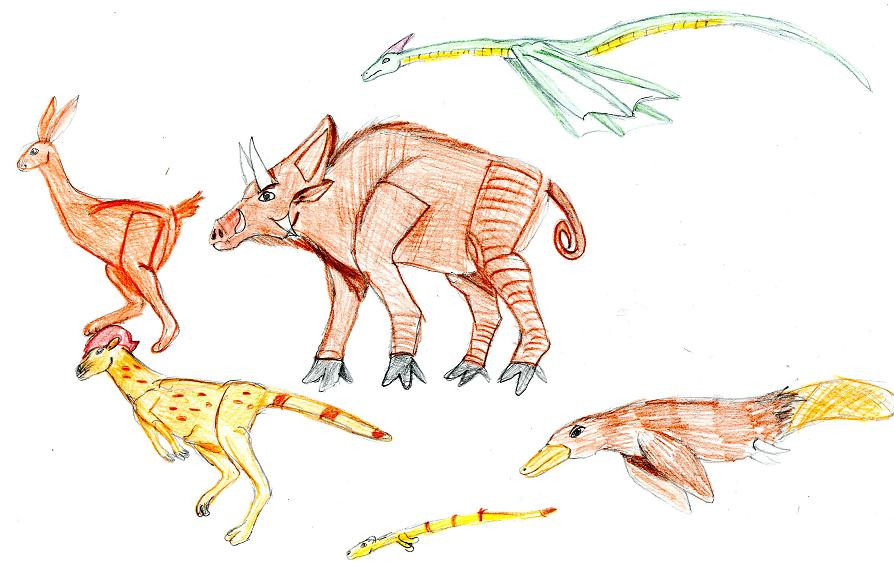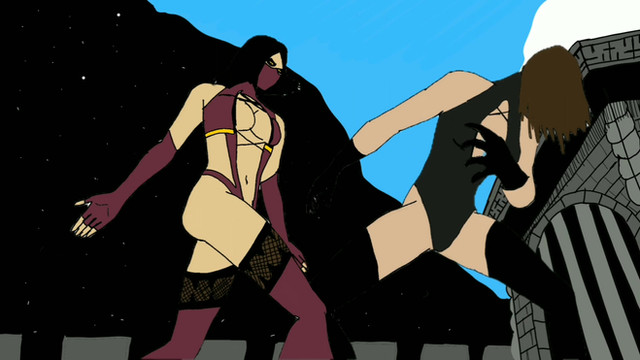HOME | DD
 SSJGarfield — Frantic Future
SSJGarfield — Frantic Future

Published: 2005-10-20 22:25:24 +0000 UTC; Views: 3923; Favourites: 19; Downloads: 27
Redirect to original
Description
More critters of Earth in the year 50 million ADUpper right:
Quetcarus (Pteradraco Quetzalus)
The Quetcarus is one of the strangest snakes that has ever evolved, because it found a way to actually fly. The wings have evolved from extended ribs. These ribs also have special joints, so they can clap. The strange horn on the Quetcarus's head is used to steer it self (Like Pteranodon did 120 million years earlier). The Quetcarus is a venomous snake that kills it's prey by falling on it like a spear, biting it and spray in a powerful venom that is strong enough to bring down a horse in just a few minutes. It feeds on large rodents, small hoofed animals, birds and lizards. When the Quetcarus has had it's fill and wants to take off again, it uses it's powerful tail-muscles to jump into the air and flapping it's wings so it will fly again. The meal will give the Quatcarus enough energy to fly for weeks, maybe even months. It's name comes from combining "Quetzalcoatl" (The Aztec god that looked like a feathered snake) and "Icarus" (A boy from the greek mythology who flew to close to the sun). It lives in the future rainforests of Africa and Asia, but it's ancestors remain unknown. The Quetcarus is about 4 meters long and has a wingspan up to 5 meters.
Left:
Rabstrich (Lagostruthius Britanicus)
The Rabstrich is a bipedal decendant of the rabbits. This strange herbivore is about the size of an ostrich and has been known to reach speeds up to 150 km/h, making it the fastest land creature since the Cheetah. Unlike the Cheetah, the Rabstrich can maintain it's high speed for longer periods of time. It lives on the grassy plains in what is now the UK and Western Europe. The Rabstrich's main enemies are the Raptogs, Bearcats and several kinds of large carnivorous rodents.
Middle:
Frilled Hornhog (Sus Ceratopiformis)
The Frilled Hornhog is a decendant of the wild boar and lives on the grasslands of North America. This huge pig resembles the long extinct Ceratopsian dinosaurs and can grow up to the size of a modern White Rhino. Frilled Hornhogs have virtually no natural predators, but the young are vulnerable to Bearcats. These creatures are solitairy, unless it's maiting season. During mating season, the males fight in head to head combats which can end up fatal to the loser. The young stay with their mother untill they are about 4 years old. The frilled Hornhog feed on grasses, roots, bulbs, worms and insects and use their formidable tusks to dig up their food.
Under from left to right:
Spotted Helmethead (Macropodus Pachycephalus)
The Spotted Helmethead is a decendant of the kangaroo and lives in the scrub forests of the Australian subcontinent. The Spotted Helmethead are 4 meters long and about as tall as an grown man. These herbivorous marsupials are now runners instead of jumpers like their ancestors were and use their tales as a ballance while running. Their 6 inch thick skulls are used as battering rams and uses them while fighting for a mate or fending of predators.
Meersnake (Suricata Ophicacus)
The Meersnake is a decendant of the meerkat and lives in the deserts of Africa where it feeds on insects, small reptiles and mammals (Including the vicious desert piranha). Meersnakes kill their prey by contricting them and can grow up to 2 meters in lenght. It lost it's hindlegs and his front legs are only usefull for grip while mating. Like it's ancestors, the meerkats, the meersnakes live in large family group.
Platyphin (Ornithorynchus Delphinus)
The Platyphin is a decendant of the platypus and is the last of the monotremes or egglaying mammals. It's about the size of a bottlenose dolphin and it feeds on plankton and small fish. The platyphin's frontlegs have evolved into flippers, all there is left of the hindlegs, are the venomous spikes which are used to back off predators, Platyphin's only come on to land if they are laying their eggs. A female will stay waiting at her nest to keep eggstealers away from their eggs. The tail has evolved to swim faster.
I hope you guys like these new creatures ^^
Related content
Comments: 12

some of the most unique ideas for for future animals ive seen
👍: 0 ⏩: 0

man you are a genius - i'm into this stuff so nobody better tell you that this is rubbish - cause it ain't. I love how you made he pig look like a triceratops and the rest are all amazing, I'm now officially a huge fan of this - you think you might add more of your creative inventions - i'm just new to DA so I have yet to upload stuff but I'll be sure to show my stuff if you're interested
👍: 0 ⏩: 1

Glad you like the pic 
👍: 0 ⏩: 1

your welcome - will do
👍: 0 ⏩: 0

I Think None of Em Will Go Extinted Will Maybe 27% of 100% Of Whale Species Well Go Extinted
-250 Million Years Pangea Utilma Will Form.
- The Most predotor Animal Would Be a Carahumankiller (Dna of a Human an a Carakiler (Future Is Wild))
See Speculative Wiki Link:[link] You'll have to See Other Pages! On It! and Read About The Carahumankiller
Link:[link]
👍: 0 ⏩: 0

anyway how do u post drawings on the website anyhow
👍: 0 ⏩: 0

so basicly what yr saying is that mammals will evolve the same way as they dinosaurs, Seems a quit likly theory so i might happen to have soime suggestions, the elephant will pretty much look the same but it will have a (Some What) longer neck and longer tail to resemble a sauropod and the tip of its trunk will resemble the head to spook smaller vememous creatures out of the way, rhinos will resemble stegosaurs and ceratopsiens, hippos will take over from ankylosaurs, big cats, wild dogs, hyenas, bears, and birds take over from theropods, antolope. deer and birds and rodents will take over from ornithopods, bats and birds will take over from pterosaurs, horses will take over from igaunodons, deer, antolope, cattle, and birds will take over from hadrosaurs, other birds and mammals and crocodiles will take over from marine reptiles, a bit crazy suggestions but their worth it
👍: 0 ⏩: 1

I'm glad you like these ideas ^^
I do like your ideas, but there are some things you should know about the animal kingdom of my future Earth.
- Most of the pachyderms will be extinct, except for the Elephants and a few South American Tapir species.
- Elephants evolve into sentient creatures (Similar to humans), along with parrots and dolphins
- Most of the hoofed mammals (like horses, deer and cattle) will be extinct as well, except for goats and antelopes.
- In the northern hemisphere, large hoofed mammals are replaced by rabbits, pigs and birds, while in the southern hemisphere, they are replaced by goats and birds.
- Most of the cetaceans will be extinct, except for dolphins which evolve into sentient creatures. The role once forfilled by the whales, will be taken over by penguins, platypus's and crocodillians.
- Goats evolve into giant, Sauropod-like herbivores.
- Insects have also grown bigger due to a rise in oxygen since Antarctica moved north to the altitude where Australia once was.
- Pinnipeds (Like seals and sealions) are mostly replaced by giant mudskippers and aquatic rodents
- Allthough the big cats of today will be extinct, the smaller felines will take their place and become bigger than ever. Some felines will also specialize in hunting tree-living animals (like squirrels, sloths and primates)
- Some bats become flightless and evolve into many kinds of animals, from small aquatic fish-hunters to giant ground sloth-like herbivores.
- The dogs evolve into dromeosaur-like predators, while foxes become bigger, more specialized predators.
- Most of the bears will be extinct as well (mostly replaced by cats and mustilidea (Like weasels and wolverines). In this future world, bears just remain on one small island of the coast of North America (today known as California)
This is just a handfull of my future world of 50 million AD
👍: 0 ⏩: 0

cool! hey, i'm back! talk to you laetr okay! love the work once more
👍: 0 ⏩: 0

Excellent job! Very interesting creatures indeed. As always, I like to learn about them via your detailed bios on them, and the illustrations are good. Of all of them, I'd have to say that I like the Quetcarus the most because it reminds me of a dragon. The platyphin is also quite interesting, and I really like what you did with the eye; it's full of expression.
👍: 0 ⏩: 0


























